|
|
|
Sort Order |
|
|
|
Items / Page
|
|
|
|
|
|
|
| Srl | Item |
| 1 |
ID:
167291
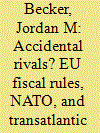

|
|
|
|
|
| Summary/Abstract |
Both theorists and practitioners continue to show interest in transatlantic burden-sharing. Resource allocation choices – both to and within defense budgets – are grand strategic choices, and membership in alliances and security communities affects how states make those choices. International security and political economy scholarship offers plausible explanations for transatlantic imbalances in military expenditures. However, NATO allies and EU member-states have pledged to one another not just to spend more on defense, but to allocate more defense resources to equipment modernization. Current scholarship does not fully explain the sources of such within-budget choices, which would help anticipate the likelihood of such pledges succeeding. Building on work by security scholars, defense and political economists, and scholars of interorganizational relations, I argue that stringent fiscal rules dampen the kind of defense spending NATO and EU strategists seek. Governments respond to increasingly stringent fiscal rules by reducing overall defense expenditures, while at the same time shifting existing defense resources to personnel, and away from equipment and operational expenditures. I find evidence in support of this argument by using education levels in the states in question as instruments for fiscal rules. This phenomenon represents a significant risk for important transatlantic strategic initiatives, namely NATO’s Wales pledge on defense investment.
|
|
|
|
|
|
|
|
|
|
|
|
|
|
|
|
| 2 |
ID:
167286
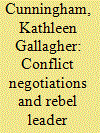

|
|
|
|
|
| Summary/Abstract |
The international community often calls for negotiations in civil wars. Yet, we have limited understanding of when and why specific rebels enter into negotiations. The emergence of a new leader in a rebel group can provide an opportunity for the state seeking to end war, but this is conditional on how leaders take power. Rebel leaders who come to power through a local selection process (such as an election) provide information to the state about the likely cohesion of the rebel group. This affects state perceptions of the viability of a rebel group as a bargaining partner in civil war negotiations. Using original data on rebel leaders in civil wars, we show that new leaders coming to power through a local selection process are more likely to get to the negotiating table than leaders coming to power in other ways. We find that the election of a rebel group leader has a particularly strong and positive effect on the chance of getting to the table. Rebel leaders that founded their own group or brought together disparate rebels to create a single group are less likely to get to the negotiating table. This article advances our understanding of conflict dynamics by offering a novel argument of rebel leader ascension and its impact on conflict bargaining and has critical implications for parties external to the conflict interested in conflict resolution. External actors seeking to facilitate lasting peace may benefit from observing patterns of rebel leadership.
|
|
|
|
|
|
|
|
|
|
|
|
|
|
|
|
| 3 |
ID:
167288
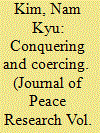

|
|
|
|
|
| Summary/Abstract |
Recent research finds an association between nonviolent protests and democratic transitions. However, existing scholarship either does not specify the pathways through which nonviolent protests bring about democratization or conduct systematic empirical analyses demonstrating that the specified pathways are operative. This article proposes four pathways through which nonviolent anti-regime protests encourage democratic transitions, emphasizing their ability to directly conquer or indirectly coerce such transitions. Most simply, they can conquer democratic reforms by directly overthrowing authoritarian regimes and installing democracies. They can also coerce democratic reforms through three additional pathways. Nonviolent anti-regime protests can coerce incumbent elites into democratic reforms by threatening the survival of authoritarian regimes. They also increase the likelihood of elite splits, which promote negotiated democratic reforms. Finally, they encourage leadership change within the existing authoritarian regime. Following leadership change, nonviolent movements remain mobilized and are able to coerce democratic concessions from the regime’s new leaders. Our within-regime analyses provide robust empirical support for each pathway. We show that nonviolent anti-regime protests conquer democratic reforms by ousting autocratic regimes and replacing them with democracies. Nonviolent anti-regime protests also coerce elites into democratic reforms by threatening regime and leader survival. These findings highlight the importance of protest goals and tactics and also that nonviolent anti-regime protests have both direct and indirect effects on democratization.
|
|
|
|
|
|
|
|
|
|
|
|
|
|
|
|
| 4 |
ID:
167289
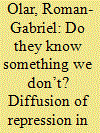

|
|
|
|
|
| Summary/Abstract |
The use of repressive strategies by authoritarian regimes received a great deal of attention in the literature, but most explanations treat repression as the product of domestic events and factors. However, the similarity in repressive actions during the Arab Spring or the intense collaboration in dissident disappearances between the military regimes of Latin America indicate a transnational dimension of state repression and authoritarian interdependence that has gone largely understudied. The article develops a theory of diffusion of repression between autocracies between institutionally and experientially similar autocracies. It proposes that the high costs of repression and its uncertain effect on dissent determines autocracies to adjust their levels of repression based on information and knowledge obtained from their peers. Autocracies’ own experience with repression can offer suboptimal and incomplete information. Repression techniques and methods from other autocracies augment the decisionmaking regarding optimal levels of repression for political survival. Then, autocracies adjust their levels of repression based on observed levels of repression in their institutional and experiential peers. The results indicate that authoritarian regimes emulate and learn from regimes with which they share similar institutions. Surprisingly, regimes with similar dissent experience do not emulate and learn from each other. The results also indicate that regional conflict does not affect autocracies’ levels of repression.
|
|
|
|
|
|
|
|
|
|
|
|
|
|
|
|
| 5 |
ID:
167292
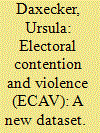

|
|
|
|
|
| Summary/Abstract |
Recent elections in Afghanistan, Bangladesh, Côte d’Ivoire, Egypt, Iraq, Kenya, Nigeria, and Pakistan have displayed substantial contestation and violence. A growing literature explores the causes and consequences of electoral contention and violence, but researchers lack comprehensive, disaggregated data establishing a substantive link between elections and violence. The Electoral Contention and Violence (ECAV) dataset conceptualizes electoral contention as nonviolent or violent events of contestation by state or non-state actors related to national elections. The data contain more than 18,000 events of election-related contention covering 136 countries holding competitive national elections between 1990 and 2012. This article describes the scope of ECAV, presents the project’s definition of electoral contention and the variables included, and outlines the coding procedure. We then compare ECAV to other datasets on electoral contention. Cross-national and subnational analyses of electoral competition and violence show that the data are useful for assessing the global and subnational implications of existing theories. ECAV addresses current data limitations by focusing on election-related contention, by using clear criteria to determine whether events are election-related, and by identifying the timing, geocoded location, and actors involved.
|
|
|
|
|
|
|
|
|
|
|
|
|
|
|
|
| 6 |
ID:
167287
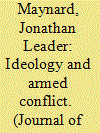

|
|
|
|
|
| Summary/Abstract |
A growing wave of scholarship suggests that ideology has demonstrable effects on various forms of armed conflict. But ideology remains a relative theoretical newcomer in conflict research, and scholars lack developed microfoundations for analyzing ideologies and their effects. Typically, existing research has primarily presented ideology as either an instrumental tool for conflict actors or a source of sincere political and normative commitments. But neither approach captures the diverse ways in which contemporary social science theorizes the causal connection between ideas and action, and both struggle to reconcile the apparently strong effects of ideology on conflict at the collective level with the relative rarity of ‘true believers’ at the individual level. This article addresses such problems by providing key microfoundations for conceptualizing ideologies, analyzing ideological change, and explaining ideologies’ influence over conflict behavior. I emphasize that ideology overlaps with other drivers of conflict such as strategic interests and group identities, show how ideologies can affect conflict behavior through four distinct mechanisms – commitment, adoption, conformity, and instrumentalization – and clarify the role of both conflict pressures and pre-existing ideological conditions in ideological change. These microfoundational claims integrate existing empirical findings and offer a foundation for building deeper explanations and middle-range theories of ideology’s role in armed conflict.
|
|
|
|
|
|
|
|
|
|
|
|
|
|
|
|
| 7 |
ID:
167290
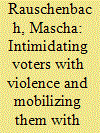

|
|
|
|
|
| Summary/Abstract |
Recent research suggests that intimidating voters and electoral clientelism are two strategies on the menu of manipulation, often used in conjunction. We do not know much, however, about who is targeted with which of these illicit electoral strategies. This article devises and tests a theoretical argument on the targeting of clientelism and intimidation across different voters. We argue that in contexts where violence can be used to influence elections, parties may choose to demobilize swing and opposition voters, which frees up resources to mobilize their likely supporters with clientelism. While past research on this subject has either been purely theoretical or confined to single country studies, we offer a first systematic cross-national and multilevel analysis of clientelism and voter intimidation in seven African countries. We analyze which voters most fear being intimidated with violence and which get targeted with clientelistic benefits, combining new regional-level election data with Afrobarometer survey data. In a multilevel analysis, we model the likelihood of voters being targeted with either strategy as a function of both past election results of the region they live in and their partisan status. We find that voters living in incumbent strongholds are most likely to report having being bribed in elections, whereas those living in opposition strongholds are most fearful of violent intimidation. We further provide suggestive evidence of a difference between incumbent supporters and other voters. We find support that incumbent supporters are more likely to report being targeted with clientelism, and mixed support for the idea that they are less fearful of intimidation. Our findings allow us to define potential hot spots of intimidation. They also provide an explanation for why parties in young democracies concentrate more positive inducements on their own supporters than the swing voter model of campaigning would lead us to expect.
|
|
|
|
|
|
|
|
|
|
|
|
|
|
|
|
| 8 |
ID:
167293
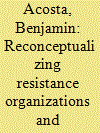

|
|
|
|
|
| Summary/Abstract |
In recent years, scholars of various forms of conflict involving revolutionary and militant organizations (such as terrorism, civil war, and nonviolent contestation) recognized that arbitrary organizational categories and typologies often leave large-N studies incomplete and biased. In moving away from nominal categorical boundaries that produce such selection biases and looking to a more generalized conception of resistance organizations, I constructed an original dataset that aims to bridge the gap between conflict literatures. Transcending traditional classifications, the Revolutionary and Militant Organizations dataset (REVMOD) consists of over 500 resistance organizations operative sometime between the years 1940 and 2014 and includes a diverse array of types of resistance organizations – many of which utilize a multitude of tactics, operate in various conflict contexts, and/or confront numerous target types. The dataset documents organizational attributes, allies, and adversaries at annual intervals (organization-years), making reliable time-series analyses possible. Tracking variables like organizational outcome-goal type and degree of achievement, political capacity, leader/s, constituent identity group, violence and demonstration levels, size, organization aliases, and several others, REVMOD breaks new ground in the collection of information on resistance organizations and can spur countless studies. A preliminary data analysis demonstrates that differences in organizational political capacity explain variation in resistance outcomes generally and in particular contexts such as civil war, terrorism, and nonviolent revolutions. REVMOD provides a unique opportunity to develop a new research paradigm for resistance studies that employs large-N empirical analyses to uncover generalities between different forms of political contention in the contemporary era, as well as to better understand why and how distinct resistance processes may produce specific outcomes.
|
|
|
|
|
|
|
|
|
|
|
|
|
|
|
|
|
|
|
|
|